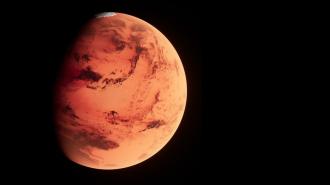The surface of Mars is barren and dry, with what little water there is tied up in icecaps or perhaps existing below the surface. But look closely at the surface, and you will see what looks like shorelines or canyons where massive floods once took place.
Billions of years ago, the atmosphere of Mars may have been denser and the air slightly warmer. By looking at deltas present on Mars, similar to river deltas on Earth, some have suggested that oceans used to partially cover the planet. (See Strange Map #1043.) Others have looked at the composition of Mars meteorites, which can show how the chemistry of Mars today compares to what the planet looked like billions of years ago. Both lines of evidence suggest that about four billion years ago, Mars’ northern hemisphere was covered with a massive ocean.
Today, this ocean is just a memory. Recent research led by the University of Tokyo and published in Nature Communications explains one reason why: Billions of years ago, Mars lost its magnetic field. Without the protection that a magnetic field offered, the atmosphere was stripped, and eventually, the oceans evaporated as water vapor in the atmosphere was lost to space.
Magnetic fields and oceans
The solar system is a harsh place. Our life-giving Sun can also take life away. The Sun produces enormous amounts of radiation that — were it not for the protective effect of our magnetic field — would fry our planet. Without the magnetic field, the solar wind would strip our atmosphere, and the oceans would evaporate and be lost to space. In other words, Earth would end up like Mars.
The Earth is the only one of the rocky planets in our solar system to have a strong magnetic field. Its presence is likely one of the major reasons why Mars and Earth are so vastly different. But billions of years ago, Mars too had a strong magnetic field. So, what happened?
How Mars lost its magnetic field and oceans
To investigate, a team led by Shunpei Yokoo of the University of Tokyo simulated the core of Mars in a lab here on Earth. The team made a material using a mixture of iron, sulfur, and hydrogen, which are believed to be present in the core of Mars.
Sulfur is probably in the core, since Mars meteorites (which sample the crust and mantle) do not contain many elements typically found alongside sulfur. Hydrogen may be plentiful in the core since Mars is close to the “snow line” in our solar system, where water ice was abundant during planet formation. “We can reasonably assume that it [the core] is Fe-S-H liquid but needs to be verified by further marsquake (Martian earthquake) observations,” Yokoo told Big Think. “The ongoing NASA’s InSight mission might tell us more in the near future.”
The team then placed this iron, sulfur, and hydrogen mix between two diamonds and heated it with a laser, simulating the high temperatures and pressures present within the core of a rocky planet. The material separated into two distinct liquids — one with iron and sulfur, the other with iron and hydrogen. Because the liquid containing hydrogen was less dense, it rose to the top. And as the liquids separated, convective currents formed.
This is similar to what would have happened in the early history of Mars. The iron-sulfur-hydrogen liquid would form convective currents as the sulfur separates from the hydrogen. These currents would have formed a protective magnetic field around the planet. But such currents are short-lived. As soon as the two liquids fully separated, the currents would stop, and the magnetic field would vanish. Eventually, the atmosphere would be stripped and the oceans would disappear.
Similar physics in the Earth’s core
This separation of iron-sulfur and iron-hydrogen liquids is also seen within the Earth, but with a key difference: temperature.
“The temperature of the Earth’s core (~6,740 F°) is much higher than that of Mars’ core,” Yokoo told Big Think. At these high temperatures, the iron-sulfur and iron-hydrogen liquids mix together. However, we do see stratification higher in the core, where the temperatures are lower. “This is the reason why the Earth’s core is stratified only at its top, while Mars’ core is entirely stratified,” Yokoo said. “It should take a very long time (like one billion years) for the Earth’s core to be fully stratified.”
We’ve got time, in other words.
These results, however, have implications in the search for habitable exoplanets. Routinely, a key metric to determine if an extrasolar planet can host life is for liquid water to be able to exist on the surface, in a location that is neither too cold nor too hot. But perhaps, a strong magnetic field should be another key metric to determine if the planet can hold onto its water. And it may very well be that magnetic fields as strong as the Earth’s are relatively rare in the Universe.
his article was reprinted with permission of Big Think, where it was originally published.





